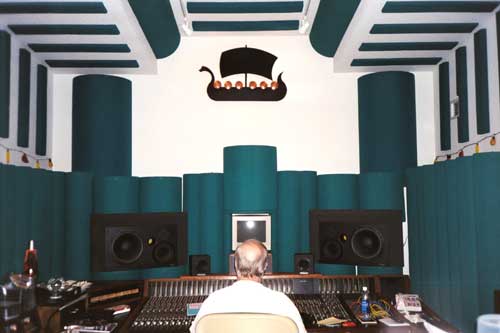Last year Surround Associates had a bit of an acoustic dilemma. While most of our surround mixing projects were done in the fine 5.1 rooms at Front Page recorders, we needed a better than average acoustic environment in our offices for editing, laybacks, DVD playback, and QC. The problem was that we werent sure how long we would be staying at the current location, so spending a ton of money to build a proper studio was out of the question. As a result, we were on the lookout for something that could provide an acoustic environment comparable to the quality that we were used to, but that was portable as well. Enter Acoustic Sciences Corporation and their 5.1 Attack Wall – the perfect combination of portability and acoustic treatment.
The Attack Wall is developed around ASCs uniquely designed Tube Trap. Tube Traps are bass traps that have a built-in diffusion membrane that is designed to scatter the high frequencies and absorb the lows. In most rooms, as a sound wave impacts a wall or corner, the acoustic energy is rearranged and the kinetic energy is transformed into sound pressure. This results in loud bass against the wall and even louder bass in the corner, as well as standing waves and unwanted reflections. Tube Traps are designed to convert this concentration of acoustic pressure into air movement within the Trap. Plus, all Tube Traps have both a reflective and absorptive side, allowing the user to tune the sonic environment as needed.
The Attack Wall is created out of an arrangement of standard Tube Traps, a Tube Trap variation specifically designed as Monitor Stands, and the portable tripod-based Studio Traps. Studio Traps tuned with the absorptive side toward the listening position are placed on either side of the monitors and act as an acoustically dead soffit. The Wall is absorptive down to 110 Hz, but loads the low bass so it vents around its bottom and top edges to eliminate any vertical bounce. Studio Traps are placed to the outside of the monitors to control side wall reflections, and are set up behind the listening position to provide diffusion and isolation off the back wall. As a result, the Attack Wall actually creates a midfield LEDE (Live End-Dead End) environment that develops the punch of farfield mains, yet still has the detailed accuracy of nearfield monitors.
Each Monitor Stand has a built in bass trap and is tuned for absorption down to 55 Hz. The Stand is extremely sturdy, can sustain weight up to 200 pounds, and is capable of handling any size monitoring system from a small single 6-inch cabinet to dual 15s. We also got the base with spiked feet on our Stands, which effectively decouples the stand from the floor and really improves the low end, making it tighter with a lot more punch. An additional piece is the Monitor Tops, which is a small Tube Trap designed to sit on top of the monitor to reduce vertical reflections even more.
For our 5.1 Attack Wall, we used five Monitor Stands, five Speaker Tops, two 20-inch corner Tube Traps, and 27 Studio Traps. ASC is extremely helpful in the process of selecting the perfect type and number of Tube Traps for the application. Given a sketch or picture of the room, theyll recommend whats required as well as the proper placement. After an initial false start that resulted in some uneven low end response, they recommended we change the position of the Attack Wall in the room from length-wise to width-wise. That did the trick, resulting in an environment that not only measures well, but sounds great and is pleasing to work in. Since we are right next door to Oasis Mastering and their high-resolution rooms, wed run back and forth to compare the sounds. We ended up getting a room response that was surprisingly close and very compatible to theirs.
After using our Attack Wall for about six months, its really hard to go back to anything else. It really feels good (a most important ingredient in a workplace), sounds great, and can be easily moved or reconfigured on a moments notice. Now I really miss it when working in most other studios.
The ASC Attack Wall can give you a great sounding environment and acoustic control with a bit of isolation, but it shouldnt be confused with good old-fashioned brute force isolation techniques. If you need to keep out the sound of helicopters, be aware that this really isnt designed to work that way. But if you need to instantly improve your listening environment, yet stay portable, the ASC Attack Wall should be high on your list of considerations.
website: http://www.acousticsciences.com/attackwall
